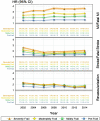Frailty and cardiovascular mortality in more than 3 million US Veterans
- PMID: 34907422
- PMCID: PMC9890630
- DOI: 10.1093/eurheartj/ehab850
Frailty and cardiovascular mortality in more than 3 million US Veterans
Abstract
Aims: Frailty is associated with an increased risk of all-cause mortality and cardiovascular (CV) events. Limited data exist from the modern era of CV prevention on the relationship between frailty and CV mortality. We hypothesized that frailty is associated with an increased risk of CV mortality.
Methods and results: All US Veterans aged ≥65 years who were regular users of Veteran Affairs care from 2002 to 2017 were included. Frailty was defined using a 31-item previously validated frailty index, ranging from 0 to 1. The primary outcome was CV mortality with secondary analyses examining the relationship between frailty and CV events (myocardial infarction, stroke, revascularization). Survival analysis models were adjusted for age, sex, ethnicity, geographic region, smoking, hyperlipidaemia, statin use, and blood pressure medication use. There were 3 068 439 US Veterans included in the analysis. Mean age was 74.1 ± 5.8 years in 2002, 76.0 ± 8.3 years in 2014, 98% male, and 87.5% White. In 2002, the median (interquartile range) frailty score was 0.16 (0.10-0.23). This increased and stabilized to 0.19 (0.10-0.32) for 2006-14. The presence of frailty was associated with an increased risk of CV mortality at every stage of frailty. Frailty was associated with an increased risk of myocardial infarction and stroke, but not revascularization.
Conclusion: In this population, both the presence and severity of frailty are tightly correlated with CV death, independent of underlying CV disease. This study is the largest and most contemporary evaluation of the relationship between frailty and CV mortality to date. Further work is needed to understand how this risk can be diminished.
Key question: Can an electronic frailty index identify adults aged 65 and older who are at risk of CV mortality and major CV events?
Key finding: Among 3 068 439 US Veterans aged 65 and older, frailty was associated with an increased risk of CV mortality at every level of frailty. Frailty was also associated with an increased risk of myocardial infarction and stroke, but not revascularization.
Take home message: Both the presence and severity of frailty are associated with CV mortality and major CV events, independent of underlying CV disease.
Keywords: Ageing; Epidemiology; Frailty; Mortality; Risk factors; Risk prediction.
Published by Oxford University Press on behalf of the European Society of Cardiology 2021. This work is written by US Government employees and is in the public domain in the US.
Figures




Comment in
-
Frailty and increased risk of cardiovascular disease: are we at a crossroad to include frailty in cardiovascular risk assessment in older adults?Eur Heart J. 2022 Feb 22;43(8):827-829. doi: 10.1093/eurheartj/ehab818. Eur Heart J. 2022. PMID: 34935046 No abstract available.
References
Publication types
MeSH terms
Substances
Grants and funding
LinkOut - more resources
Full Text Sources
Medical

